Sandra Gulland's Blog, page 26
August 9, 2012
A therapist for writers: only in Hollywood (alas)
I must be quick. I’ve been wrestling with my email all morning and I’ve a manuscript to revise.
There has been a lot of excitement this week. The Next Novel has found a wonderful home with U.S. publisher Doubleday. I couldn’t be happier!
In the meantime, two drive-by bits. One re. a great article: “Hollywood Shadows; A cure for blocked screenwriters” by Dana Goodyear in The New Yorker. It has something to say for any kind of writer, and with humour (which is how we survive The Writing Life).
And, speaking of humour, do watch this absolutely wonderful book trailer for Laurie Frankel’s novel Goodby for Now. It’s an example of what a good book trailer can do. I hope it goes viral!
I adore Eleanor Roosevelt, the lady with a squirrel around her neck. And Einstein: “I’m younger now than when I started it. That’s how good this book is.”
What’s your favourite part?
July 28, 2012
Gutenberg’s fingerprint: how much is a smudge worth?
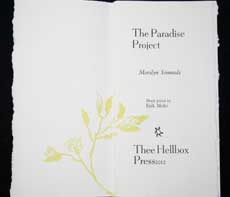
I’ve posted a few times of late about The Paradise Project, author Merilyn Simonds‘ limited-edition letterpress publication of short stories. In an age when publication is becoming more and more digital, I’m finding this hand-made centuries-old process fascinating.
Merilyn has been blogging about the process. Her latest, Gutenberg’s fingerprint, is especially evocative.
The studio is crowded today: all the people who worked onThe Paradise Project have gathered to see the final pages printed and put the press to bed. …
Mico looks at the press as he will one day look at the person he loves. “He let me run this thing when I was 14, and ever since, I’ve wanted to come back. It was a big mistake. Now I never want to leave.”
Me neither.

On the news front, I’m awaiting the delivery of my edited last draft. I’m told that there are only about 50 small suggestions. (That’s nothing!) I’m also told I was described by an editor as “Queen of Revision.” I love that!
I’m considering changing my main character’s name from Claude (her historical name) to Claudine or Claudette. A number of readers get confused by what they consider a male name. I like the androgynous name and it suits Claude’s androgynous character, but I don’t like confusing readers (at least unintentionally). Your thoughts? Preferences? I’m leading toward Claudine.
I put off sending out my newsletter until later in August so that I could give more concrete information about publication date, a possible title, the Josephine documentary as well as Sandra Gulland Ink publications.
Yes, there is a lot coming to a head next month!
July 11, 2012
A Josephine challenge … I love it!
I’m writing a newsletter to send out (finally!), and in looking on YouTube for the clip about the Josephine documentary I was part of last summer, I discovered this wonderful recommendation for the Josephine B. Trilogy by Jen Knoch:
Writing is long, arduous and solitary work. Readers like Jen Knoch make it very, very special.
July 8, 2012
On paper-making: the hard (and beautiful) way

I’ve been following the creation of Merilyn Simonds’ hand-set book The Paradise Project with interest. Above, an end-paper, made with flowers from Merilyn’s gorgeous gardens.
Merilyn writes about meeting Emily, the papermaker, and the fascinating process of making the endpapers in “The Papermaker’s Tear” here.
Basically, Emily explains:
“You can make paper two ways: by dipping the screen in the pulp, which ends up with a very homogenized paper, or the Japanese way, by draining pulp through a screen in a box, which is harder to control, but I seem to need to do things the hard way.” She says the last bit with a shy smile.
They chose lilies from Merilyn’s garden because “You’re looking for a fibre that will feather apart … something that will dissolve in water and suspend, but also bond with other fibres, not hang out on top on its own.”
Merilyn had lots of lilies: “Three great swaths of twelfth-of-July lilies, 40 feet or more, and several smaller clumps of citrinas, Catherine Woodberys, crimson pirates, gentle shepherds, stella d’oros, and many happy returns.” Into the endpapers they went!
These endpapers are simply gorgeous.
To read more about The Paradise Project, see my posts here and here.
July 4, 2012
Letterpress love! The making of a rare collector’s edition
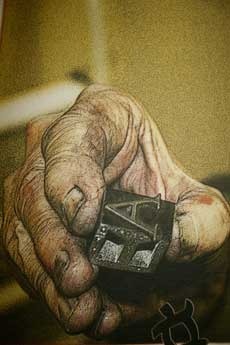
I blogged on the weekend about Canadian literary writer Merilyn Simonds‘ The Paradise Project being published in letterpress.
What does that mean?
It means that her new collection of short-fiction is being published in hand-set monotype, printed on a 1890 Chandler-Price press.
Hugh Barclay of Thee Hellbox Press notes: “Letterpress, unlike offset, leaves a tactile impression in the paper that will sometimes sparkle in the slanting morning sun.” (I love that: it only all our written words would actually sparkle.)
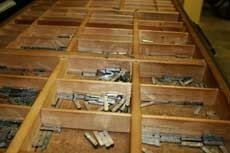
But this edition really goes further than that. Delicious details:
• A numbered edition of 300 copies. (And my copy, reserved long ago, is #1!)
• Hard cover, case bound, allowing it to be opened flat.
• The cover boards are wrapped in Ajisia Gold, a colourfast Japanese paper. (The name translates into hycinthia.)
• Some uncut pages. (Don’t books with uncut pages simply thrill you?)
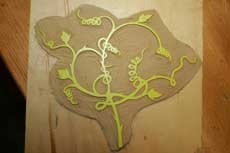
• Merilyn’s son, artist Erik Mohr, has created over fifteen outstanding lino cuts to go with the stories.
• The endpapers are individual works of art created by Emily Cook, reflecting Merilyn’s gardens. The paper contains flowers from her gardens. All of this reflects the theme of the collection: the stories in the main deal with gardens and the human situations around them.
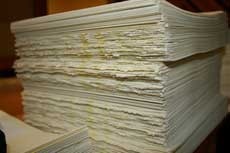
• The book is printed on St. Armand’s mold made acid free paper known as “salad” paper.
• All materials used in the book—including adhesives used in binding—are acid free to ensure longevity.
Almost a half-century ago, I stumbled into a used bookstore in San Francisco seeking a book by the poet Kenneth Patchen. The owner guided me to a numbered edition with cover art by the poet. I flew out of that store with that book in my arms! It is now one of my treasures. (And worth quite a lot.)
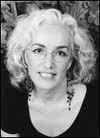
If you or someone you know would love a book as art object—made painstakingly in the old-fashioned way—and, in addition, if you’d like a work by Merilyn, who is such a fine literary writer (see her books here), I recommend that you contact Hugh to reserve one of these numbered copies of The Paradise Project for yourself. The price: $150 Cdn. is very reasonable for such a collector’s edition. Hugh Barclay can be reached at h.w.barclay@sympatico.ca.
Ask the editor: on rejection
This series from Algonquin is great:
Algonquin is a wonderful publisher, and for good reason.
Some other videos from Algonquin:
Kathy Pories on the Bellwether Prize
Chuck Adams on Water for Elephants
Enjoy!
June 30, 2012
Paradise unfolding
Nobody crafts words like Merilyn Simonds. If you’re a word-craft-lover, I think you would very much enjoy reading about the evolution of The Paradise Project: her collection of flash fiction, now being printed in slow motion by letterpress …
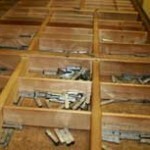
… on St. Armand’s mold-made “salad” paper, with endpapers made from her garden and lino cut illustrations made by her son, artist Erik Mohr.
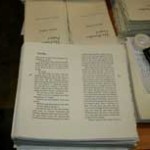
The Paradise Project is a collection of her award-wining short stories with gardens at their core, a bed-rock of imagery that is always with her.
Merilyn on the “easy” work of writing:
It is an easy job, at least on those days when the words are there lining up, compliant, but feisty, too. Even when they aren’t, when I spend hours lugging commas from here to there, shovelling in new phrases, axing them out again, prying words apart, wedging in fresh ones, even then what survives always looks easy. The better the writing, the easier it looks.
Merilyn writes evocatively, emotionally, sparely. If you’re like me, you’ll tear up as well.
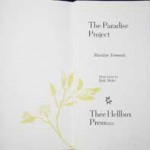
The Paradise Project is being hand-published by Hugh Barclay, book artist and owner of Thee Hellbox Press. “I’m working on the last signature and I hope to put the press to bed on July 15th, providing that the stars and the moon are properly aligned.”
I long ago put in an order for one of these precious books. There won’t be many such. (Only three hundred, in fact.)
“Books of this artistic quality are only published about every 10-20 years and normally sell for 4-5 times what we are asking,” notes Hugh. The books are selling for $150 (about the cost of a forgetable night out in Toronto). If you are interested, e-mail Hugh to reserve a copy: h.w.barclay@sympatico.ca

Late-breaking news: because I put in my order long ago, my copy is book #1!!!
June 29, 2012
“Done! Finished! Completed!”
What play opens with those words? I Googled it and nothing came up. It was produced in my high school, and the boy who spoke the line was my boyfriend. I think of that line every time I finish a draft: Done! Finished! Completed!
Never, I know: never done, never truly finished, never ever completed. A novel is forever a WIP: officially that means “Work In Progress,” but I think “Work In Process” is more apt. But for now, for a week at least, The Next Novel is put to rest, sent off through the ethernet to my editor and agent. (Yay, I met my deadline.)
I’ve been working long hours on it daily for well over a month. Mistress of the Sun was published in the spring of 2008, and I began this novel shortly after. Four years ago! I’m exhausted and just a little bewildered. What now?
Now: I’m a proud grandmama! I get teary just typing that. Our beautiful, spirited daughter gave birth to—only last Sunday!—a beautiful (and no doubt spirited) little girl, Alexandra May Sudds. We’re all so in love! Baby-bliss. There’s nothing like it.

May 30, 2012
May 28, 2012
Seized by story
I’m going to be brief, because I should be revising The Next Novel.
I’ve been side-stracked a bit this week by information and stories about my mother’s family. (I am now in danger of catching the genealogy bug.)
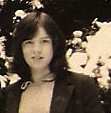
I’ve long intended to dedicate The Next Novel to the memory of my mother’s oldest sister, my aunt Alecia. Ironically—or not—a number of the stories are about her.
My novel has a great deal to do with theater, and Alecia was, to me, delightfully dramatic. Her clothes closet was the size of a bedroom, full of every hat and frill imaginable. Such fun to play in with my cousins!
Alecia was always the one to take us “young’uns” to the theater: we needed “culture,” she said, but most of all she liked to see us dressed up. (I remember running excitedly to greet my cousins. I was in jeans and a t-shirt. They were in frilly dresses and white gloves.) Alecia was dynamic, fierce and girlish, almost an Auntie Mame figure to me, as well as a Mother Hen, invariably eccentrically and flamboyantly dressed. She adored stories of queens; she was a queen herself. Did she live in a fantasy? She had a huge collection of antique tea cups, but where was the garden party? She never found it; she was one of a kind in our Birkenstock Berkeley world.
I remember her as an older woman (although she was only 62 when she died). As a teen, she’d been a beauty, and news-worthy—big-time.
Why?
At 16 Alecia eloped to Reno, Nevada, with a musician in a band that had come to play at her high school—at least that’s what I was always told. He wasn’t much older than she was, and his family—lo and behold—were related to the Rockefellers. (The beau’s grand-father was an early business partner of John D. Rockefeller.)
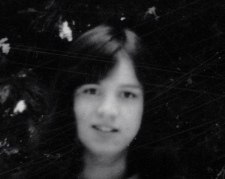
It was a difficult transition, no doubt, for my bohemian-Berkeley young aunt. In no time her new mother-in-law was demanding that the state of California proclaim the marriage null and void. The state declared it legal, so the mother-in-law proceeded to get them divorced.
The youngsters were separated and my aunt Alecia moved back home to Berkeley with her librarian father, mother and five siblings. By now she was pregnant, of course.
The birth of a girl made headlines, for the baby was technically an heiress, liable to inherit as much as 12 million, one newspaper estimate put it, in ’30s dollars. (You do the math: lots.) “Million-dollar baby born in Five ‘n Dime” was how my mother recalled the headlines: humiliating.
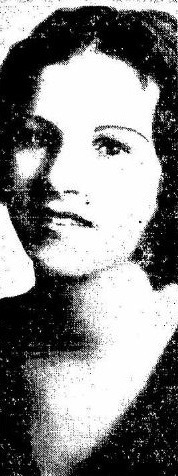
(This photo of Alecia was the one splashed all over the newspapers.)
My mother claimed it only brought them unhappiness. The “windfall” never amounted to much more than lives put on hold in anticipation of something that never really materialized.
But details have emerged from these old news clippings—and a story, or rather, a mystery, has seized me.
Alecia, 17, was in the hospital, having just given birth. Reporters and lawyers circled. The father of her estranged husband called her three times. And then he killed himself.
This, for me, is how stories begin: with something like a “story seizure,” attended by an aching, persevering curiosity. I long to know: Why was he repeatedly calling? Why did he kill himself? What was their relationship? How did the young mother feel?
But then, invariably: truth intervenes. The muddled truth. The story above is the one that burned itself into my imagination. But then, of course, I had to go back and review the facts. The father-in-law did not call Alecia in the hospital, but several years later (curious, still), begging her to get on a plane to come see him. And yes, that night, he did kill himself—according to Alecia. The inquest deemed it an accident.
My dedication reads: “In memory of my Aunt Alecia, the drama queen of my youth.”
Drama, indeed. Drama, mystery, and profound tragedy.




